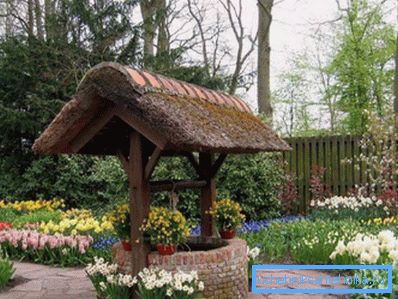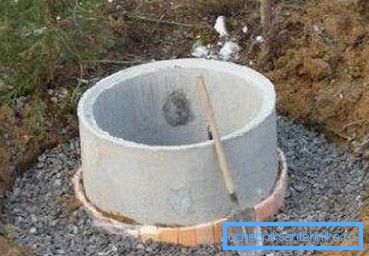How is the blind area around the well
According to the production technology, a blind area for a well almost does not differ from a similar arrangement around a residential building or, say, a tea gazebo in the garden. Its main task is not to allow melt and rain water to accumulate near the walls, thus prolonging their operational resource, and getting to the well is much more pleasant.
Below we will talk about installation methods, brands of concrete, and also see the thematic video in this article as an additional material.

Materials and fill
Note. The blind area is a concrete or asphalt strip, which finishes the building (structure) along the perimeter. This strip is always able to a certain slope from the wall to the ground for the flow of water. Its width usually depends on the type of soil, the roof canopies over the structure, as well as the will of the owner himself.
Concrete production

- In order for you to get the blind area of the well with your own hands, you will also have to independently produce a solution that should not collapse under the influence of temperature drops, precipitation and mechanical loads. Some for some reason believe that a regular cement-sand mortar is sufficient for pouring, but this is a serious mistake.
- This mixture is good only for plaster or screed floor, where there is already a hard base. In the conditions of the street, such a frozen mass is not able to survive for a long time - it cracks and collapses under the influence of any climatic conditions.
- In this situation, you have to make concrete, which, in addition to sand and cement, includes crushed stone of small fraction or, at worst, sifting out of this rubble. You will definitely have to choose sand without clay impurities, since the latter dissolves under the influence of moisture, therefore, the casting will soon collapse. Kneading can be done either with a concrete mixer or manually, and although the latter option is more time consuming, it is equally effective, especially when you have experience of such work.
- To prepare the concrete, water is first poured into the container, and then the necessary dose of cement is poured and all this is thoroughly stirred to a concentration of very liquid sour cream so that dry powder does not remain. After that, add sand and get a solution, but very rare to use.
- And only then rubble is poured into the tank and stirred to such a state that the mixture is not kept on an inverted spade or trowel.
Council If the solution after the next kneading is stuck in the concrete mixer blades, then it is not necessary to get it out of there. Just when you do the next, then after pouring water, throw a couple of shovels of rubble - after a minute of another rotation of the barrel, it will be clean. But this is only possible on a continuous stream, so that the solution does not clutch.

- The table that you see in the photo above shows the number of components in proportion to each other depending on the concrete grade. The most commonly used brand is B2.5 (M300), but if you want to lay tiles on top of the screed, then even M100 can be dispensed with.
Assembly work

In the upper image, you see the principle of a soft blind area, where 1 is a layer of turf; 2 - backfilling; 3 - rubble pillow; 4 - sand cushion; 5 - geotextile membrane; 6 - protected object (foundation or well ring). In this case, the instruction allows you to do without concrete, while maintaining the natural landscape.
But one problem arises here, especially if the water intake is made by a bucket using a gate - water will in any case be spilled on the ground, and precipitation will arrange dirt around the perimeter.
Therefore, best of all, this is a concrete pavement of the well, which will give an opportunity to calmly approach it in any weather. But pouring should be done, of course, not on the ground, but on a sand-rubble cushion, according to the principle of the one you saw on the upper image. Only to equip such a base should not be on the surface, and going deep around the perimeter of about a bayonet spade.
But the depth here will depend more on the rigidity of the soil, that is, the softer it is, the deeper it is to dig, so that the pillow also has a solid foundation.
The width of the strip should be calculated by two parameters:
- First of all, so that it is convenient to go to the well and even go around it and;
- Secondly, from the roof of the house (cap) water should fall on the concrete, and not on the ground.
But these parameters are minimal and if, for example, you want to lay a screed with paving slabs or clinker tiles, flagstone or other decorative stone, then the width should be increased as needed.
When calculating the width of the blind area, do not forget that you need to comply with the slope, somewhere 1 cm / 1 m, but at the same time its edge should rise at least a couple of centimeters above the ground - so it will be less dirty. Therefore, the wider you make the tape, the more you have to lift the edge closest to the well, and this cannot be done indefinitely (find out here what to do if there is water in the well).

If you make a narrow blind area, for example, as in the top photo, then its price will be low, but it will be able to perform its functions fully, protect the perimeter of the well from dirt and make possible a normal approach to the upper ring. Only with such a small width it is better to increase the slope, making it, for example, 2 cm / 1m.
Conclusion
Of course, you understand how to make a blind area around the well, especially since it is not at all difficult, in any case, compared with the installation of the well itself. But in any case, even the most beautiful blind area, even if covered with a decorative stone or tile, will have a nondescript look if it is in the mud. Therefore, you also have to concrete the approach, making a narrow path.